Translate this page into:
An empirical study on the job satisfaction and turnover intention of health-care professionals: Moderated moderation approach
Address for correspondence: Dr. Yasir Hayat Mughal, Department of Health Administration, College of Public Health and Health Informatics, Qassim University, Al-Bukairyah, Saudi Arabia. E-mail: y.hayat@qu.edu.sa
This is an open-access article distributed under the terms of the Creative Commons Attribution-Noncommercial-Share Alike 3.0 Unported, which permits unrestricted use, distribution, and reproduction in any medium, provided the original work is properly cited.
This article was originally published by Qassim Uninversity and was migrated to Scientific Scholar after the change of Publisher.
Abstract
Objective:
The objective of this study was to investigate relationship between job satisfaction and turnover intention of health-care professionals using the moderated moderating approach.
Methods:
Explanatory sequential research design was applied. Non-probability convenience sampling technique was used to determine the sample size using Weiers formula. Scales adopted in the current study were validated through exploratory and confirmatory factor analysis. To test the hypothesis correlation, the hierarchical multiple regression was used. In the second stage, semi-structured face-to-face interviews from 35 interviewees were conducted and transcribed in Nvivo.
Results:
Job descriptive index, cognitive style index (CSI), cognitive style indicator, and turnover intention scales were found to be reliable. Furthermore, correlation analysis shows that the factors of job satisfaction were significantly correlated with turnover intention. In addition, findings of the interviews highlighted the importance of cognitive styles for increasing the job satisfaction of health-care professionals.
Conclusions:
Study concludes that the involvement of health-care professionals in making health-care policies enhances their job satisfaction that also reflected on their performance. Moreover, it also reduces their turnover intention of workforce.
Keywords
Cognition
decision-making
job satisfaction
turnover intention
Introduction
Turnover intention is a mental process and it needs a lot of thinking for decision-making. The decision of whether to leave the job or to stay at a job is very difficult.[1,2] There are direct and indirect costs associated with turnover intention. For example, the recruitment and selection process, training, and development process need time and a lot of cost paid by organizations to train new employees.[3] Meanwhile, it brings a lot of burden to existing employees for replacing the previous employee.[4] Organizations, especially in health care, are very difficult to retain employee[5] as it embroils a lot of thinking and decision-making how to reduce turnover intention. Allinson and Hayes[4] have developed cognitive style index (CSI). They have divided human mind into two parts; one is called left brain it is also called analytical and second part is called intuition or right brain. People with analytical style tend to collect information first and then they make decisions while intuitive people make decision on basis of their experience, judgment, and feelings.[6] Later on, Cools and Broeck[7] developed cognitive style indicator (CoSI). She has divided analytical style into three more parts and named those constructs knowing, planning, and creating for making decisions. It is believed that decision-making plays very important role in reducing turnover intention and increasing job satisfaction. Hence, it was very crucial to use a well-reported and validated instrument for decision-making in this study. Job satisfaction is an international phenomenon,[8] in the 1960s, more than 4000 articles were published on job satisfaction. However, it gains popularity after the theories given by Herzberg two factor theory, Vroom’s[9] theory, McGregor Theory, Theory X and Theory Y, and job characteristics model by Hackman and Oldham[10] Spector theory of job satisfaction.[11] All these researchers confirmed that there are few attributes of job satisfaction that is held constant, for example, salary, supervisor, promotion, colleagues, work, work environment, and job security.[12,13] Later on, researchers added more variables in theories of job satisfaction but for this study, researchers have chosen the above-mentioned variables.[7,13] There is an American researcher named Judge, Klinger, and Simon[13] conducted and reported many articles on job satisfaction. From the findings of this study, it was indicated from the results that instrument was found reliable and valid.[14,15] CoSI was only related with job and supervisor while CSI was not significantly related with any factor of job satisfaction. In addition, there was moderated moderating effect on satisfaction and salary only but no moderated moderation effect on other variables.[16,17] Themes emerged from qualitative interviews and findings also supported the quantitative findings. Based on the above literature, we hypothesized proposed the following: H1: There is a negative relationship between predictors and criterion variables, that is, satisfaction, salary, supervision, promotion, coworkers, work environment, work itself, CSI and CoSI, and turnover intention. H2: There is a moderated moderating effect of CSI, CoSI on factors of job satisfaction, and turnover intention.
Methods
Explanatory sequential research design
There are six research designs for mixed methods research; however, in this study, explanatory sequential research design is adopted, it has two stages of research. In the first stage, quantitative data were collected and analyzed, while, in the second stage, interviews were conducted for qualitative study and analyzed. Qualitative data were used to supplement, support, and strengthen the quantitative results. For quantitative study, positivism philosophy was employed whereas, for a qualitative study, a phenomenological approach was adopted as recommended by Creswell,[18] Collis and Hussey.[19] Pragmatism considers the happening of events to the situation. In a mixed method, the researcher is capable to solve the problem using both methods that help researchers to go deep into the problem or the issue understudy. Smith et al.[20] suggested the use of at least 10 interviewees for the interpretative phenomenological approach (IPA), however, in the second stage of qualitative analyses, we have used 35 interviewees which is above the Smith threshold, that is, 10 participants. The majority of scientists and researchers have used survey questionnaires for the assessment of behaviors and attitudes of individuals and organizations.[21] Thus, the survey is a common, popular, and easy method that allows the researcher to collect a very big data in less time and cost, therefore, in this study, survey was employed to collect data.
Population and sampling
The population of the study consisted of health-care professionals in the Riyadh region of Saudi Arabia that included 124 administrative and 23,246 staff members, thus, N of the study was 23,370. Since the population was big so it was impossible to contact every member to obtain their responses, therefore, sampling was essential. Probability and non-probability sampling techniques are given by researchers in health care. Both have their strengths and weaknesses.
In this study, researchers have used simple random stratified sampling, whereas, convenience sampling technique was applied to collect responses from the respondents. Weiers[22] has developed a statistical formula [SD2/((E2/Z2) + (SD2/N))] for the finite population to determine sample size. Therefore, researchers have employed the Weiers formula. 95% confidence level is suggested by social scientists to determine the sample size for the finite population, which is equal to 1.96 z-value. Table 1 illuminates the procedure to determine the sample size of the study in hand.
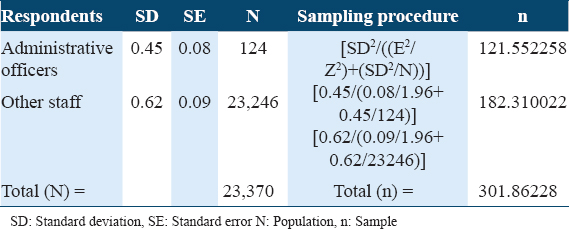
Measures and procedures
The job satisfaction instrument was adopted from Busari et al.[8] while turnover intention was taken Mughal et al.,[4] and for CoSI, it was adopted from Cools and Broeck.[7] Therefore, the instrument developed by Cools and Broeck[7] was used in this study. The questionnaires were administered among administrators and staff. The questionnaire included four sections; first is about job satisfaction, second is about turnover intention, and the third is about the CoSI; all these sections were measured on a 5-point Likert scale. Job satisfaction has seven items, turnover has three items, and CoSI has 18 items, while the fourth section was demographic variables.
Data analysis
SPSS was used for quantitative data analysis. Exploratory factor analysis, bivariate correlation, and hierarchical multiple regression (HMR) were run to investigate the best fit model. Further for moderation, a procedure given by Aiken and West[23] is used. First, the variables were mean centered to reduce the multicollinearity problem. Then, interaction term was created to test moderation results. Thereafter, all variables were entered into HMR according to theoretical significance. Then, interaction plots were plotted one standard above the mean and one standard deviation below the mean. Nvivo 8 was used for qualitative data analysis; nodes were developed, where from themes emerged [Figures 11 and 12]. Template analysis was used to analyze themes. Since, ideas and themes are parcel part of the respondents’ lives. Researchers also focus on the phenomenological flavor of themes. The current study was conducted in 2020.
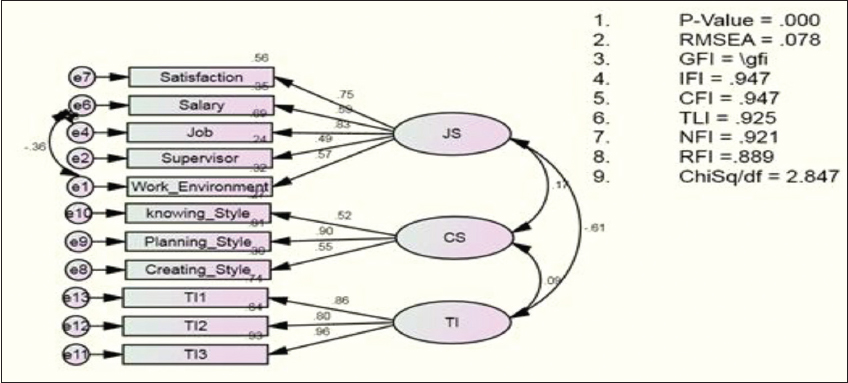
- Measurement model. RMSEA: Root mean square error of approximation, GFI: Goodness of fit index, IFI: Incremental fit index, CFI: Comparative fit index, TLI: Tucker Lewis index, NFI: Normed fit index, RFI: Relative fit index. Chi-sq/df: Chi-square/Degree of freedom
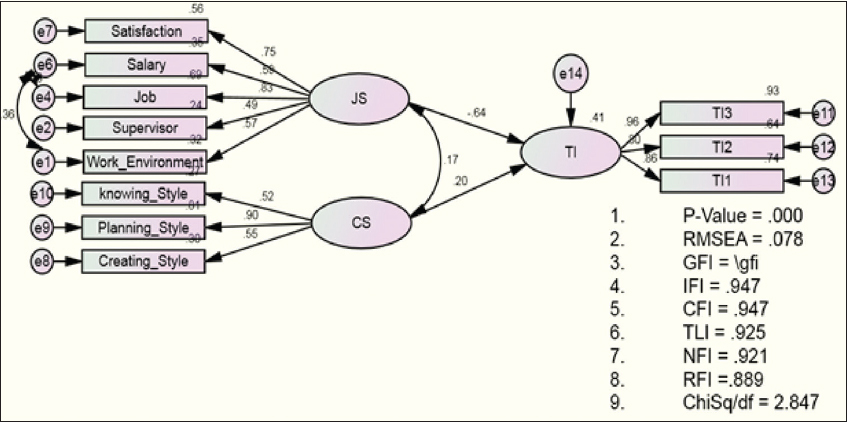
- Structural model. RMSEA: Root mean square error of approximation, GFI: Goodness of fit index, IFI: Incremental fit index, CFI: Comparative fit index, TLI: Tucker Lewis index, NFI: Normed fit index, RFI; Relative fit index. Chi-sq/df: Chi-square/degree of freedom

- Moderation model

- Satisfaction CoSI, CSI. CSI: Cognitive style index, CoSI: Cognitive style indicator
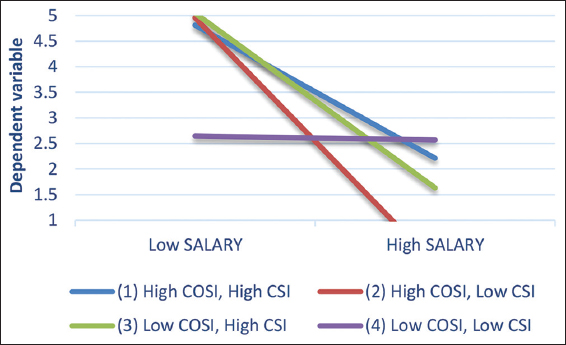
- Salary CoSI, CSI. CSI: Cognitive style index, CoSI: Cognitive style indicator
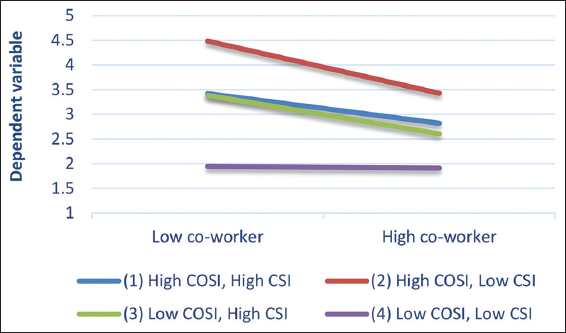
- Coworkers CoSI, CSI. CSI: Cognitive style index, CoSI: Cognitive style indicator
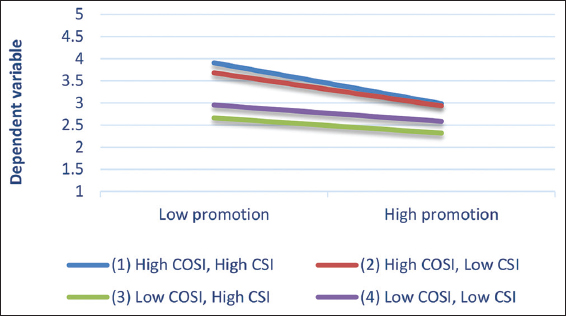
- Promotion CoSI, CSI. CSI: Cognitive style index, CoSI: Cognitive style indicator

- Supervisor CoSI, CSI. CSI: Cognitive style index, CoSI: Cognitive style indicator
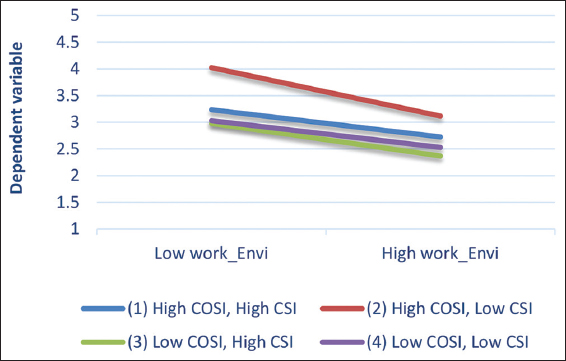
- Work environment CoSI, CSI. CSI: Cognitive style index, CoSI: Cognitive style indicator
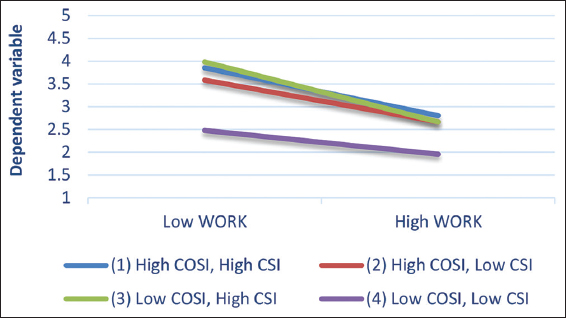
- Work CoSI, CSI. CSI: Cognitive style index, CoSI: Cognitive style indicator

- Word cloud taken from NVIVO
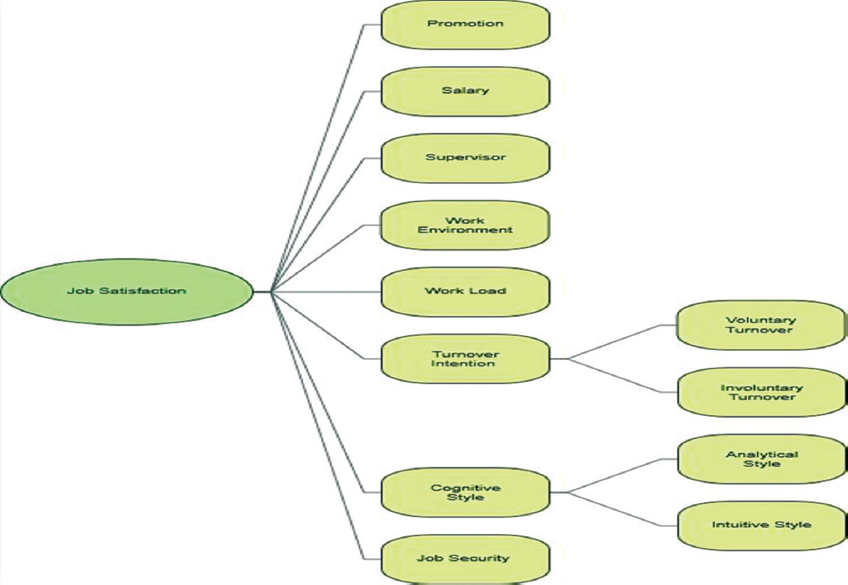
- Qualitative model taken from NVIVO
Results
A total of 301 employees have participated in the current study. There were total 225 male participants, that is, 74.75%, 76 females have participated in the current study, that is, 25.2%. Majority of the participants belong to public sector health-care organization such as 198 (65.7%) while 34.2% belong to private sector organizations. Further analyses of results revealed that most of the professionals were foreigners and belong to India, Pakistan, Egypt, and Sudan, that is, 49% Indian, 33% Pakistani, 9.9% Egyptian, and remaining Sudan. In the first run of exploratory factor analysis, it is necessary to check the sample is adequate for EFA or not? This objective was accomplished by Kaiser-Meyer-Olkin (KMO) of all variables KMO for cognitive style was recorded KMO = 0.7 which is above 0.5 Hair et al.[24] for job satisfaction KMO = 0.775, for turnover intention KMO = 0.703. Bartlett’s’ test of sphericity for all variables was significant. Promax was used for rotation, as shown in Table 2.

Table 3 presents the results of the correlation between predicting variables and the criterion variable. As expected, satisfaction is negatively related with turnover intention while positively but weakly related with CoSI and CSI, that is, r = 0.463, P < 0.05 and r = 0.91, r = 0.91, P > 0.05. Further examination of the relationship between salary and turnover intention is found moderate and negative but significant, that is r = −0.502, P < 0.05, but alary is not related to CoSI and CSI.

Further examination of results shows that promotion is negatively but significantly related with turnover intention, that is r = −0.332, P < 0.05, but promotion is negatively related with CoSI, that is r = −0.063, P > 0.05 while promotion is positively but insignificantly related with CSI, that is r = 0.028, P > 0.05. In the same way, further examination of correlation results shows that job/work is negative but significant related with turnover intention but also significant related with CoSI but weakly related with CSI, that is r = −0.412, P < 0.05; r = 0.134, P < 0.05; and r = 0.024, P > 0.05. Furthermore, examination revealed that coworkers/colleagues are also negative but significant related with turnover intention but weakly and positively insignificant with CoSI and CSI, that is r = −0.250, P < 0.05; r = 0.070, P > 0.05; and r = 0.050, P > 0.05.
Likewise, results revealed that supervisor is negative and significant but weak related with turnover intention also significant related with CoSI but insignificant related with CSI, that is r = −0.373, P < 0.05, r = 0.112, P = 0.05, and r = 0.012, P > 0.05. Furthermore, work environment is negative and significant with turnover intention but insignificant with CoSI and CSI, that is r = −0.304, P < 0.05; r = 0.105, P > 0.05; and r = 0.035, P > 0.05, so on the basis of discussion from correlation results, it is clear that our hypothesis 1 is substantiated and accepted. This means that there is a significant positive relationship between the predictors and criterion variables of the study, Table 3.
There is different goodness of fit indices given by Hair et al. [24] for model fitness. Fit indices and their fitness range values are given in Table 5.
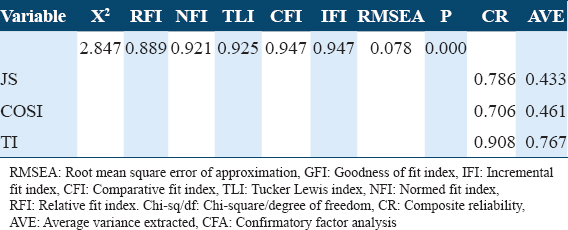
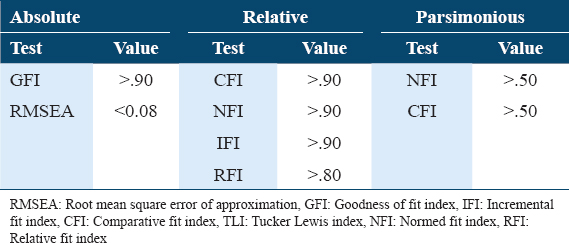
Table 4 and Figure 1 illustrate results for model 1 of the study. AMOS-SEM was used to develop a measurement model. In Figure 1, measurement model is given. All the factor loadings are higher than 0.5 except one construct, that is, job it is 0.49, two constructs are deleted from analysis because of low factor loadings. All the goodness of fit index values met the required level, that is, Chi-square =2.847, RFI = 0.889, NFI=0.921, TLI = 0.925, CFI = 0.947, and IFI = 0.947, P < 0.01, all the values are in the specified range so the model if fit. Further analysis of results revealed construct reliabilities and average variance extracted values. Construct reliability for job satisfaction and CoSI is 0.786 and 0.706 while AVE value is 0.433 and 0.461 below 0.5 but construct reliability is met criteria, so reliability and validity are established.[25]
Figure 2 was developed for the structural model. In this model, job satisfaction is independent; cognitive style is also independent (moderator is considered independent) and turnover intention is criterion variable. Table 6 shows the goodness of fit indices. It is found that model is fit, and all the goodness of fit indices are in the specified range, that is, χ2 = 2.847, RFI=0.889, NFI=0.921, TLI=0.925, CFI=0.947, IFI =0.947, and RMSEA=0.078. Further analysis of results revealed that correlation between job satisfaction and cognitive style is r = 0.17, P < 0.01, and impact of job satisfaction on turnover intention is beta β = −0.64, P < 0.05 and β = 0.20, P < 0.05 is also significant and R2= 0.41 it means that job satisfaction and cognitive style show variance on turnover intention 41%. It means that there is a negative impact of job satisfaction on turnover intention and the positive impact of cognitive style on turnover intention.

Moderating effects of cognitive style on job satisfaction and turnover intention were also checked in AMOS-SEM. Results are highlighted in Figure 3, it is found that job satisfaction has a negative impact on turnover intention, that is, β = −0.81, P < 0.05, while cognitive style has positive effect β = 0.10, P < 0.05, an interaction term was created by multiplying job satisfaction and cognitive style β = 0.24, P < 0.05, R2 = 0.37 it means job satisfaction, cognitive style, and interaction term shows variance on turnover intention 37%. Next HMR is used for testing hypothesis 8, that is, there is moderated moderating effect of CoSI and CSI on job satisfaction factors and turnover intention. This moderated moderation results are also known as three-way interaction. All seven independent variables and their three-way interaction results are presented in Table 7.
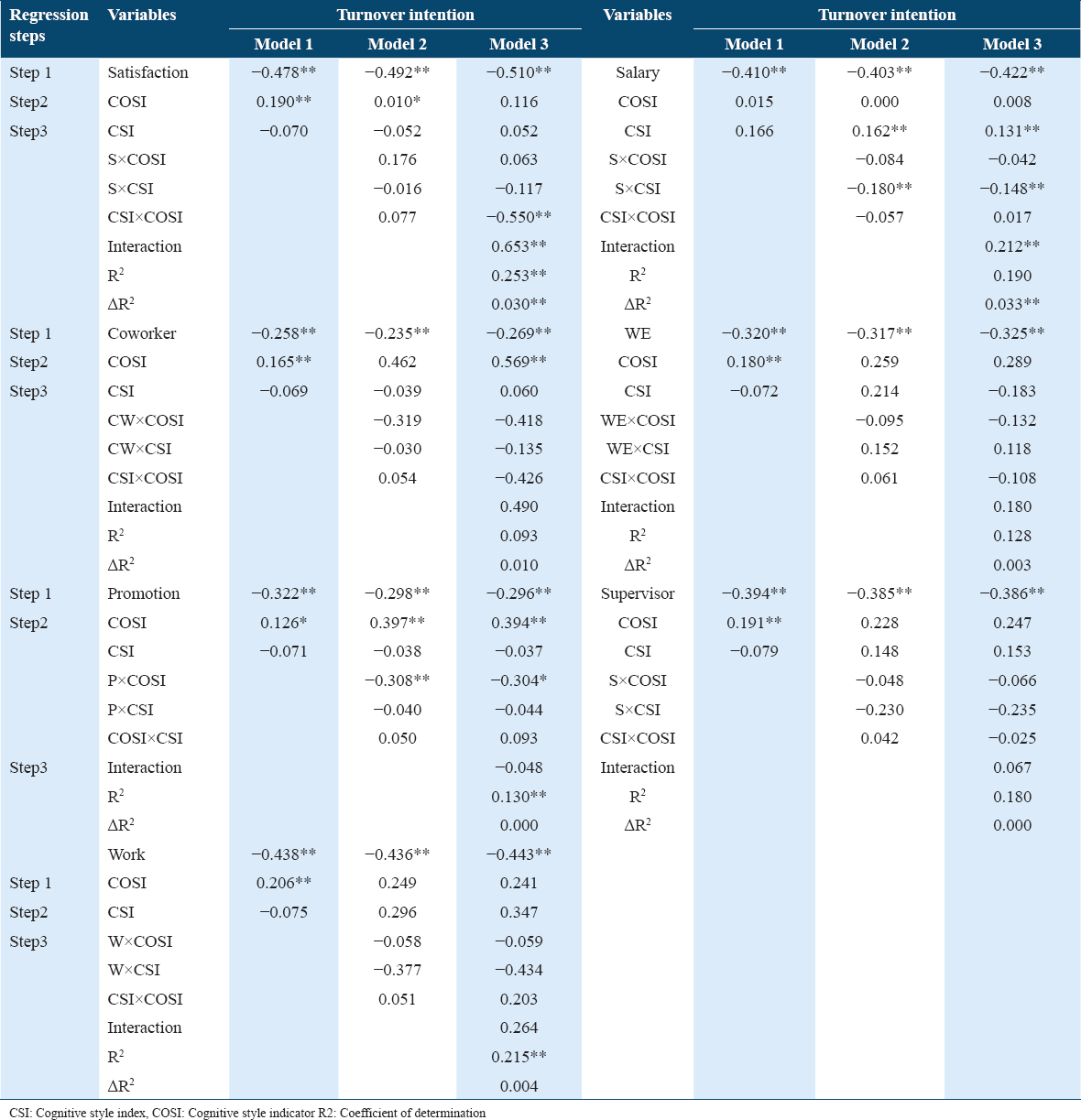
In this study, CoSI is used as a moderator and the CSI is used as a moderated moderator. First examination of three-way interaction done with satisfaction CoSI and CSI and turnover intention. The results revealed that the interaction term is significant and ∆R2 is also significant it means that there is moderated moderation and CSI does act as a moderated moderator on the CoSI, satisfaction, and turnover intention. Three-way interaction was conducted using the same procedure and found that CSI does not act as a moderated moderator on CoSI, coworkers, and turnover intention, there is no significant interaction term and ∆R2 is also not significant although there is changed in ∆R2 is recorded.
Further examination of the results revealed that there is moderated moderation occurs on the relationship between CoSI, promotion, work, work environment, and supervisor because all interaction terms were insignificant and there is no significant change in recorded in ∆R2 but when CSI is used with salary and turnover and CoSI it does acts as moderator because interaction term is significant and ∆R2 is also significant so CSI acts as a moderated moderator on CoSI salary and turnover intention so our hypothesis 2 is partially accepted for satisfaction and salary. Table 7 highlights the moderated moderation result of this study.
To interpret the interactions, all three-way interactions were plotted, with cut values of one standard deviation below the mean and one standard deviation above the mean on each moderator variable. Examination of the first plot revealed that the CSI, that is, CSI is acting as a moderated moderator on CoSI, that is, COSI.
From the plot, it is also revealed that low CoSI and high CSI interact with high CoSI and high CSI. Hence, this plot [Figure 4] is consistent with the results shown in Table 3 for satisfaction. Further analysis of results shows that low COSI and low CSI fully moderate the relationship between salary, turnover intention, and CoSI. Hence, this plot [Figure 5] is consistent with the results shown in Table 7 for salary.
Similarly, examination of the plot [Figure 6] shows that CoSI and CSI interact with each other, but these two variables do not interact with coworker and turnover intention so three-way interaction does not exist in this Figure 6. Further examination of plot [Figure 7] indicated that high CoSI and high CSI and high CoSI and low CSI interact with promotion and turnover intention but low COSI and low CSI do not interact so there is no three-way interaction exists. Further examination of plots revealed that Figures 8-10 also consistent with regression results.
Discussion
In this study, we have used 35 interviews, whereas Creswell[27] Smith et al.[29] suggested the use of at least 10 interviews for qualitative analysis. Furthermore, Silverman[25] suggested that in qualitative research, qualitative data must be natural. There should be no coding and the researcher is not allowed to minimize data. Semi-structured interviews are the best source for qualitative study as in this study researchers aimed to understand the phenomena in-depth, additionally; this method allows the interviewees to ponder freely on the issues. In the first instance, researchers got the consent of all the interviewees then an interview guide was provided to them as Rubin and Rubin[26] considered an interview guide as the scaffolding of the interview. The date and time for the interview were fixed mutually as practiced by Smith et al.,[20] and interviews were recorded suggested by IPA. All interviews were transcribed verbatim. As asserted by Remenyi et al.,[27] the researcher has read transcription thoroughly and made necessary corrections to make sense of it. Below is the narration and analyses of the interview data. Different questions were asked from interviewees about different attributes of their current job. Interviewees respond in the following manner: “Regarding salary my package is according to government rules and you know in public sector rules are already defined for each cadre and scale. So, salary is not an issue.” Another respondent explained “My package is attractive, and I am happy with this package, but I am not satisfied from the workload in this organization that is beyond the capacity, sometimes, I have to complete the work of my colleagues.” Other interviewees highlighted the issue of inter-relationships. Their concerns are as under “Relationships with colleagues are fine but my senior colleagues are not supportive. If I need equipment and consumable office supplies, I have to wait a few weeks or even a month. Although I know they have their limitations as they have to follow the rules, and they cannot buy from their own money since they have to ask the purchase department to make things available that is why it takes time. Efficiency of work is concerned, comparatively; the progress of work is slower than the private sector.” Other attributes of job satisfaction are highlighted in this way as under: “Work environment is good, yet promotion policies are inflexible, you know you have to fulfill the criteria for promotion, once you fulfill it, then you will get it” one of the respondents discussed about job security that “Job security in the public sector is very high since these are tenured jobs… you can easily work for whole life…. and nobody can disturb you if your conduct is aligning with the rules of business.” Responses of respondents regarding turnover are mentioned below. “I don’t have the intention to leave that job in future I am satisfied with my current job.” Other respondents highlighted their concerns in this way… “Since I am working in public sector organization so I have no intention to leave that job, however, if I get a better opportunity, then I could decide to move.” Cognitive style is used for making decisions. Different cognitive styles were used by researchers to know their role in decision-making, therefore, CSI and CoSI were used in this study. Respondents were of the view that: ”First I try to find the reason of problem… and it is better to know the history and background of the problem then you are better able to find the better solution, so I used to analyze the situation first as you know, we all are human beings and we have emotions and feelings so sometimes we cannot control our feelings and, in such situation, I use to make spontaneous decisions. However, I am intuitive by nature.” This study has some limitations which can affect some potential areas. First, the sample size of this study is small and collected from health-care organizations only and that to in Riyadh region, thus findings of this research could not be generalized to other sectors such as banks and universities, therefore, it will be better if future studies may use large sample size. Second, this study is quantitative; future studies can use mixed methods and longitudinal data for more thought provoking results. The third limitation is methodological limitations. This study has used two moderators, whereas, future studies can use multiple or series of mediators to come up with novel results and findings. Other dimensions of cognition such as feelings, emotions, and judgment can be used in future studies.[28,29]
Conclusions
It is imperative for the health-care organizations to enhance the satisfaction of their professionals by applying different strategies for involving them in decision-making policies, this not only increases their job satisfaction but also reduces turnover intention of workforce. Furthermore, management and leadership of the health-care professionals play very important role in increasing the job satisfaction of their professionals.
Authors’ Declaration Statements
Ethical approval
The current study was carried out without receiving any funding and was approved by Qassim University Ethical Committee.
Data availability
All data sets are available with authors and it will be produced on reasonable request.
Authors’ Contributions
G.M.K and Y.H.M participated in manuscript drafting, conceptualization, the idea of study design, and methodology. F.A and S.A.P.: Perform review, editing, formal data analysis, and validation. All authors have read and agreed to the published version of the manuscript.
Acknowledgments
Authors acknowledges to all study subjects for their active participation to complete the study.
References
- Two ways interaction between lower order terms of left brain and right brain cognitive style and relationship between satisfaction and turnover intention. Int J Inf Syst Soc Change. 2017;8:71-83.
- [Google Scholar]
- Analytical cognitive style moderation on promotion and turnover intention. J Manag Dev. 2017;36:436-64.
- [Google Scholar]
- Synthesizing the literature of leadership, job satisfaction, and trust in leadership. Afr J Hosp Tourism Leisure. 2020;9:1-16.
- [Google Scholar]
- Moderating intuition effect on cognitive style relationship concerning promotion and turnover intentions among academicians. Sci Int. 2015;27:6375-80.
- [Google Scholar]
- The cognitive style index:A measure of intuition-analysis for organizational research. J Manag Stud. 1996;33:119-35.
- [Google Scholar]
- Access Perks. Available from: https://blog.accessperks.com/employee-engagement-loyalty-statistics-the-ultimate-collection
- Development and validation of the cognitive style indicator. J Psychol. 2007;141:359-87.
- [Google Scholar]
- U. Level of job satisfaction and turnover intention among academicians. Soc Sci. 2016;11:1362-72.
- [Google Scholar]
- Work and Motivation. New York: Wiley; 1964.
- Work Redesign. Reading, MA: Addison-Wesley Publications; 1980.
- Measurement of human service staff satisfaction:development of the job satisfaction survey. Am J Community Psychol. 1985;13:693-713.
- [Google Scholar]
- Pathways towards sustainability in organizations:Empirical evidence on the role ofgreen human resource management practices, and green intellectual capital. Sustainability. 2020;12:1-24.
- [Google Scholar]
- Time is on my side:Time, general mental ability, human capital, and extrinsic career success. J Appl Psychol. 2010;95:92-107.
- [Google Scholar]
- Pay and Job Satisfaction:A Comparative Analysis of Different Saudi Arabian Commercial Banks. MPRA Paper No. 16059 2009
- [Google Scholar]
- The effect of human resource management practices in enhancing employee performance in catholic institutions of higher learning in Kenya. Int J Bus Adm. 2011;2:189.
- [Google Scholar]
- Moderating role of analytical left-brain cognitive style in decision making on relationship between satisfaction factor and turnover intention. Gomal Univ J Res. 2017;2:189-99.
- [Google Scholar]
- The mediating effect of job satisfaction on the relationship of HR practices and employee job performance. Empir Evid Higher Educ Sect. 2019;8:78-94.
- [Google Scholar]
- Research Design:Qualitative, Quantitative, and Mixed Methods Approaches (3rd ed). London: Sage; 2009.
- Business research:A practical guide for undergraduate and postgraduate students. In:Business and Management:An Introduction to Process and Method. London: Palgrave Macmillan, Sage; 2013.
- Interpretative Phenomenological Analysis Theory, Method and Research. London: Sage Publications; 2009.
- An experimental case study of the successes and failures of job enrichment in a government agency. J Appl Psychol. 1976;61:701.
- [Google Scholar]
- 2011. Introduction to Business Statistics. (7th ed). Available from: https://www.amazon.com/Introduction-Business-Statistics-Sixth-Instructors/dp/0324650574
- Multiple Regression:Testing and Interpreting Interactions. Thousand Oaks, CA: Sage Publications; 1991.
- Interpreting Qualitative Data:Methods for Analyzing Talk, Text and Interaction (3rd ed). Thousand Oaks, CA: Sage Publications; 2006.
- Qualitative Interviewing:The Art of Hearing Data (2nd ed). Thousand Oaks, CA: Sage Publications; 2005.
- Doing Research in Business and Management:An Introduction to Process and Method. Thousand Oaks, CA: Sage Publications; 1998. p. :309.
- 2019. Ashley Butler Employee Engagement and Retention and Loyalty Statistics. Available from: https://blog.accessperks.com/employee-engagement-loyalty-statistics-the-ultimate-collection
- 2017. Global Studies Report, Tanner Institute. Available from: https://www.inc.com/todd-nordstrom/79-percent-of-employees-quit-because-theyre-not-ap.html







